DP-900: Microsoft Azure Data Fundamentals
To complete the sentence, select the appropriate option in the answer area.

what is most likely to occur in the future.
what occured in the past.
which actions you can perform to affect outcomes.
why something occured in the past.
Answer is what occured in the past
Descriptive Analytics tells you what happened in the past. Diagnostic Analytics helps you understand why something happened in the past. Diagnostic analytics ask about the present. They drill down into why something has happened and helps users diagnose issues. Descriptive analytics ask about the past. They want to know what has been happening to the business and how this is likely to affect future sales.
To complete the sentence, select the appropriate option in the answer area.
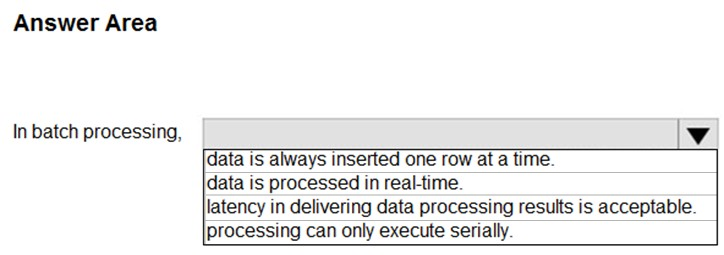
A
B
C
D
Answer is C
When to use batch processing.
You might expect latencies when using batch processing. For many situations, however, this type of delay before the transfer of data begins is not a big issue - the processes that use this function are not mission critical at the exact moment.
Reference:
https://www.bmc.com/blogs/what-is-batch-processing-batch-processing-explained/
To complete the sentence, select the appropriate option in the answer area.

A
B
C
D
Answer is A
Transcribing audio files can be considered as a form of descriptive analytics. Descriptive analytics is a type of analytics that focuses on summarizing historical data to gain insights into past events and trends. In the case of transcribing audio files, the process involves converting spoken language into written text, which can then be analyzed to understand what was said in the past.
Cognitive analytics, on the other hand, is a type of analytics that involves using machine learning algorithms to analyze unstructured data such as text, images, and speech. Cognitive analytics is focused on identifying patterns and insights in data that are not immediately apparent to humans, and it is often used for predictive and prescriptive analytics.
Reference:
https://docs.microsoft.com/en-us/azure/cognitive-services/speech-service/batch-transcription
For each of the following statements, select Yes if the statement is true. Otherwise, select No.
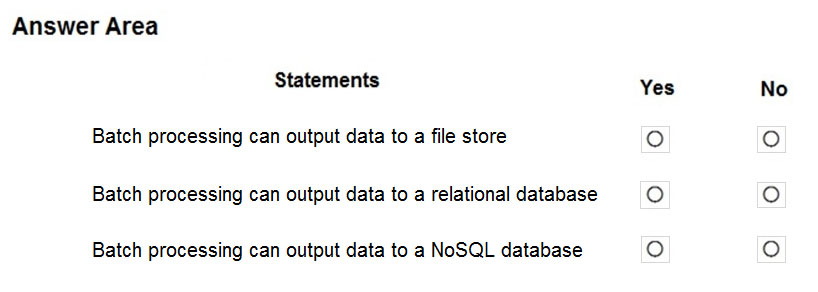
Check the answer section
Statement 1: Batch processing can output data to a file store.
Yes. Batch processing can indeed output data to a file store. This is a common use case where processed data is stored in file systems like Azure Blob Storage or other similar cloud-based or on-premises file storage systems.
Statement 2: Batch processing can output data to a relational database.
Yes. Batch processing can output data to relational databases. After processing, the data can be structured and stored in relational database systems like Azure SQL Database, MySQL, PostgreSQL, or other relational databases.
Statement 3: Batch processing can output data to a NoSQL database.
Yes. Batch processing can also output data to NoSQL databases. This is particularly useful for unstructured or semi-structured data. NoSQL databases like Azure Cosmos DB, MongoDB, or others can be used for storing the results of batch processing tasks.
Reference:
https://docs.microsoft.com/en-us/azure/architecture/data-guide/big-data/batch-processing
To complete the sentence, select the appropriate option in the answer area.

Cognitive
Descriptive
Predictive
Prescriptive
Answer is Descriptive
Generally speaking, data analytics comes in four types;
Descriptive, to answer the question: What's happening?
Diagnostic, to answer the question: Why's happening?
Predictive, to answer the question: What will happen?
Prescriptive, to answer the question: What actions should we take?
Reference:
https://azure.microsoft.com/en-us/blog/answering-whats-happening-whys-happening-and-what-will-happen-with-iot-analytics/
Match the types of visualizations to the appropriate descriptions.
To answer, drag the appropriate visualization type from the column on the left to its description on the right. Each visualization type may be used once, more than once, or not at all.

Check the answer section
Box 1: Tree map
Treemaps are charts of colored rectangles, with size representing value. They can be hierarchical, with rectangles nested within the main rectangles.
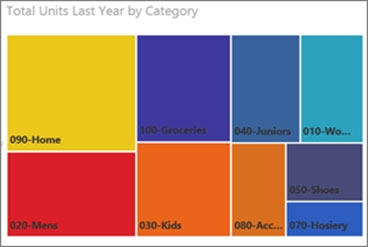
Box 2: Key influencer
A key influencer chart displays the major contributors to a selected result or value.
Box 3: Scatter
Scatter and Bubble charts display relationships between 2 (scatter) or 3 (bubble) quantitative measures -- whether or not, in which order, etc.
Reference:
https://docs.microsoft.com/en-us/power-bi/visuals/power-bi-visualization-types-for-reports-and-q-and-a
For each of the following statements, select Yes if the statement is true. Otherwise, select No.
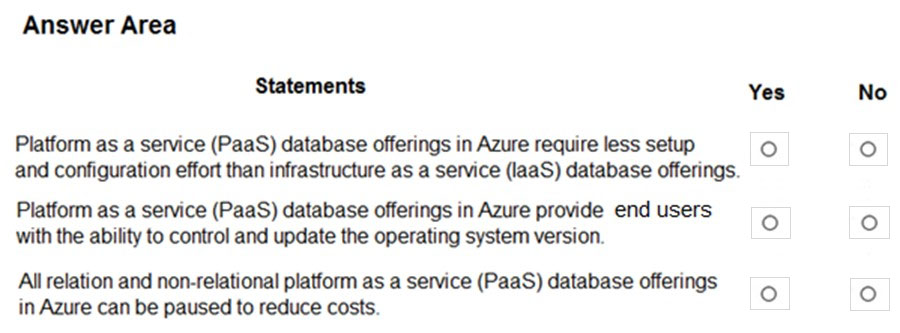
Check the answer section
Box 1: Yes
Like IaaS, PaaS includes infrastructure ג€" servers, storage, and networking ג€" but also middleware, development tools, business intelligence (BI) services, database management systems, and more. PaaS is designed to support the complete web application lifecycle: building, testing, deploying, managing, and updating. PaaS allows you to avoid the expense and complexity of buying and managing software licenses, the underlying application infrastructure and middleware, container orchestrators such as Kubernetes, or the development tools and other resources
Box 2: No
You manage the applications and services you develop, and the cloud service provider typically manages everything else.
Box 3: No
There really is no way to pause / stop billing for your Azure SQL Database. Microsoft's official answer "Yes, you can export your database. Delete the Azure SQL database and that will pause billing. Then when you need it you can create a new database and import your previously exported DB."
Reference:
https://azure.microsoft.com/en-us/overview/what-is-paas
Which statement is an example of Data Manipulation Language (DML)?
REVOKE
DISABLE
INSERT
GRANT
Answer is INSERT
Data Manipulation Language (DML) affect the information stored in the database. Use these statements to insert, update, and change the rows in the database.
BULK INSERT
- DELETE
- INSERT
- SELECT
- UPDATE
- MERGE
Reference:
https://docs.microsoft.com/en-us/sql/t-sql/statements/statements
For each of the following statements, select Yes if the statement is true. Otherwise, select No.
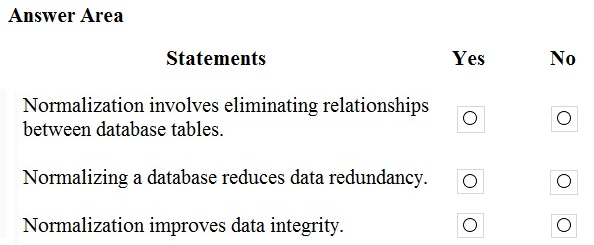
Check the answer section
Answer is No - Yes- Yes
Normalization is the process of organizing data in a database. This includes creating tables and establishing relationships between those tables according to rules designed both to protect the data and to make the database more flexible by eliminating redundancy and inconsistent dependency.
Reference:
https://docs.microsoft.com/en-us/office/troubleshoot/access/database-normalization-description#:~:text=Normalization%20is%20the%20process%20of
To complete the sentence, select the appropriate option in the answer area.

A
B
C
D
Answer is C
ELT-a target data store powerful enough to transform data. ETL-data that is fully processed before being loaded to the target data store.